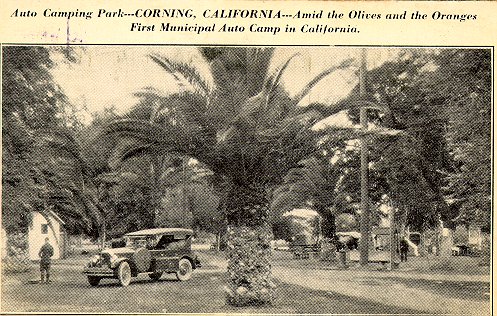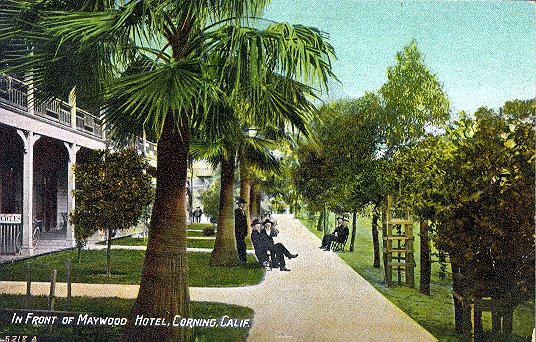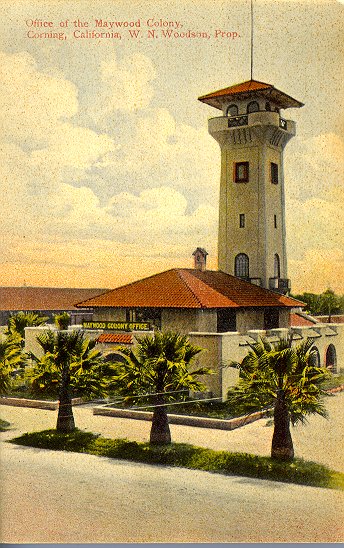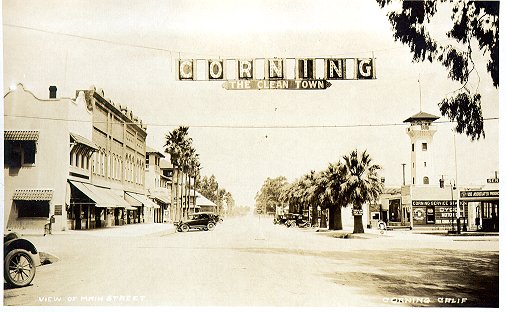In the 1880's Corning was a typical sleepy western railroad town. And then along came the right man to
the right place at the right time--Warren N. Woodson, a young man of high hopes, burning ambition and
ideas, diligent working habits and visions of success.
It was an age of independence and hard work, and many low and middle income families were coming to corning
to settle in a warm healthy climate and were looking for small farms and plots of land, within their means,
to frame and build houses on. And the Corning area seemed to be "a most congenial spot" and Woodson's
"Camelot," the Maywood Colony.
While his name was not even included in the original partnership name, he was a partner in the company,
and devoted his whole life to his dream, by working day and night, weekends and holidays promoting the
Colony.
This letter was written by Woodson on Thanksgiving Day, 1898: "About my own hours--having just so much
to do, and having to have it done at set times, especially advertisements and matter for the Advocate, I
have set up hours for myself that I work to without deviation. Up at 7, breakfast and at the office before
8; one half hour for luncheon, work till 6 p.m. till 8 I read papers, then put in time till 11 on Advocate
work. This pencil matter, I work over at the office on machine before sending it to the printer. Sunday
is general cleaning up day at the office, and so it goes during the work season. Well, it is nearing
6 p.m. and as the widow and orphan are awaiting my arrival, I will conclude and visit with them this
evening."
While the partners came and went, Woodson stayed on and lived the rest of his life in Corning, working,
organizing and pushing the various community organizations, and advertising continuously. He helped those
settlers who needed it to the best of his ability, and was the most respected man in town for his
contributions to the community, and was honored by many people and organizations in his old age and
mourned at his death. his life was Corning and the surrounding Maywood Colonies.
Woodson was born on September 2, 1863, near Sacramento. As a young boy, his family moved near Fresno.
From that time on he was self supporting and also helped provide for his mother, brother and two sisters.
He picked acorns for 10 cents a grain sack, herded sheep, and tended a band of hogs for five months. He
had to drop out of school after the fourth grade, but he taught himself all of the three R's and much
more by constant reading in his spare time.
His mother, Margaret Hatton Woodson, decided the family should move to Red Bluff to be with her parents.
There Warren washed dishes for 75 cents a day at the Tremont Hotel and waited on tables. He studied
voraciously in his spare time. In 1879 he worked for the Sierra Lumber Company, and through his
initiative and hard work, he rose to become bookkeeper for the mill. He then became clerk for the
general store of Clark and Mayhew and handled the agency for distributing the San Francisco newspapers.
He entered into the community life of Red Bluff, was active in politics, and in 1886 was appointed
postmaster of Red Bluff, a position he held for four years. In 1887 he met and married a school teacher,
Florence Bettis, daughter of a former Tehama County treasurer, Ransom S. Bettis.
During his tenure as postmaster of Red Bluff, he received many letters from other parts of the United
States inquiring about the availability of small plots of land that might be for sale in the area--letters
from people who could not afford the large acreage that it took to raise grain and sheep. These letters
gave him the idea of developing small tracts of land for sale, and led to the development of the Maywood
Colony. One of the greatest newspaper editors of his day, the famous Horace Geely predicted "Fruit
growing is destined to be the ultimate glory of California," and that inspired Woodson to plant fruit trees.
He met and became an associate of Charles F. Foster, who had been the sheriff of Tehama County for two terms,
and who was elected to the state legislature as senator in 1882 representing Tehama, Colusa and Glenn Counties.
A contract was entered into between George Hoag, one of the original pioneer settlers, and Foster, for the
purchase of 3107 acres adjacent to and east of Corning, at a price of $77,675.00 ($25 per acre). The original
real estate sales firm was called Moore, Foster & Co., with officers at 634 Market Street, San Francisco.
The "Moore" in the firm was Colonel O.E. Moore, who had formed a Chicago suburb named Maywood. The name
Maywood was chosen for "The Maywood Colony." The partnership name was soon changed to Foster, Benchley
& Woodson, then later to Foster, Treakle & Woodson, and lastly to Foster & Woodson.
William F. Luning was hired to survey and divide the tract into ten-acre plots, each facing a planned
street. The lots were to be sold on an installment plan, allowing the average family to make its own
living off the land and also afford to pay the installments. This was the beginning of one of the largest
real estate speculations of its time, gradually developing into subdivisions containing moe than 40,000
acres. The association planted fruit trees in spite of ridicule from the old time settlers. Nine hundred
trees was the average planting on a 10-acre site.
Corning at this time was only 161 acres in size and was owned by The Pacific Improvement Co., a construction
and development firm owned by the Central Pacific Railroad. George Hoag sold the acreage to the railroad
on the condition that it erect a depot and passenger station where trains would stop, and also lay out
a townsite with lots to sell. In 1882 Luning and F.J. Nugent laid out the town.
The Maywood Colony eventually surrounded the town of Corning. Foster remained in Corning to handle the
local problems, established offices in Boston, Chicago and New York. He wrote and placed advertising in
the Chicago Times Herald, Chicago Tribune, and newspapers in New York, Ohio, Missouri, Massachusetts,
Pennsylvania, Illinois and California. He advertised extensively in farm and church magazines, primarily
the Christian Herald. He published his own periodical and called it "The Maywood Colony Advocate."
Ministers were given discounts on the purchase price of their own parcels for each new buyer they could
find. They even had a rebate system of $45 cash to every person who bought a ten-acre parcel before
Jan. 7, 1893. Over $500,000 was spent on advertising through the years, in days when the dollar would
buy several times what it will today.
Woodson organized and promoted an exhibit from The Maywood Colony and Tehama County at the Chicago World's
Fair in 1893, and through the persistence of Foster, the Board of Supervisors of Tehama County voted to
appropriate the sum of $3,500 for the purpose of collecting an exhibit of Tehama County products to be
sent to the fair. In supervising the exhibit, Woodson diligently promoted the Maywood Colony.
Red Bluff citizens also helped get the Maywood Colony going by giving their endorsement for publication
in the various newspapers, etc.
THE OPINION
Corning, Cal., Feb 1, 1892
We, the undersigned, are acquainted with the tract of land
adjourning the town of Corning, known as the Maywood Colony,
and certify to the fact that it is rich, fertile land, well situated for
and adapted to grape and fruit raising. The quality of the soil is
such, together with the regular and abundant rainfall, that irrigation
is not needed to produce good results. The land is well worth
the price at which it is offered and is undoubtedly a good
investment.
We are also acquainted with Messrs. Foster & Woodson. Mr.
Foster has served four years as sheriff and two years as State
Senator of this county. Mr. Woodson was postmaster in Red
Bluff for four years. Both gentlemen are well known and
thoroughly reliable.
W.R. HALL, County Clerk
A.M. McCOY, District Attorney
J.L. BARHAM, County Assessor
A.L. BROWN, County Treasurer
H. KRAFT, Banker and Supervisor
M.R. HOOK, Supervisor
JOHN F. ELLISON, Superior Judge
JOHN BOGGS, State Senator
C.E. FISH, Sheriff, Tehama County
C. CADWALLADER, President Bank
D.D. DODSON, Postmaster, Red Bluff
Gen. N.P. CHIPMAN, Horticulturist and Attorney at Law
Maps and brochures and pictures of various fruit trees, orchards and homes that people had built here
were distributed to prospective purchasers. Copies of the hometown paper, The Observer, were also
mailed out.
Meanwhile, with orchardist George H. Flournoy helping, more than a million fruit trees were planted.
Oranges, prunes, almonds, walnuts, peaches, figs, grapes, apples, lemons, plums, pecans, black walnuts,
pears, cherries, berries--all could be grown. A family could plant its own fruit trees, vegetable
gardens and orchard, have its own well dug, and buy a cow, some chickens, a few sheep, etc., and be
completely self-sufficient.
The olive seedlings that were planted did the best of all. The climate was just right, and they
didn't require as much care as other fruits, so Woodson began to advertise the colony as another
"Garden of Eden," like the lands in the Bible.
The Observer reported in 1892 that "Mr. M. Lown started building a neat new real estate office for
the firm of FOSTER, TREAKLE & WOODSON, owners of the celebrated Maywood Colony. Hitherto parties
seeking land had to go out nearly two miles to see the manager of the Colony. It is in a good
position near the railroad station."
An ad in the New York Times dated Dec. 18, 1895, read:
$40 an acre on easy terms gets warranty
deed to good fruit land in California; boat
landing, depot, schools, churches, stores,
and 600 people now on tract; perfect
climate, place healthful and rapidly
developing; orange, olive, fig, almond,
grape, peach, prune, pear and apricot
orchards growing to perfection; get out
prospectus. FOSTER & WOODSON,
84 Adams St. Chicago.
Of course there arose many problems that had to be ironed out. Grasshoppers and jack rabbits seemed
to thrive. And many diseases attacked the trees. Olive trees seemed to be the only trees that were
relatively immune. Turkeys and chickens were imported to eat the grasshoppers and certainly thrived
well.
Many of the colonists needed help with their trees, and so a horticulturalist, H.B. Gallaher, a
leading fruit grower, was hired by Foster and Woodson, and put in charge of planting much of the
land to orchards. Then he cared for them until the colonists arrived to take over. This was a very
attractive selling point, and by 1893 they had a crew of 70 men and 60 horses working the orchards.
Much lumber was needed to build the colonist's houses, so the partners started their own lumber
yard, The Maywood Colony Lumber Shed, for sash, doors, blinds and seasoned lumber.
Some people wanted to live in town with neighbors and commute to their orchards. In 1893 the partners
developed the Maywood Addition to Corning, 160 acres east of the railroad. It was plotted out by
surveyors into town lots and also included space for a cooperative cannery and a packing house for the
colonists. In the center of these new city lots was a large public park for recreation. It was now
designated Woodson Park.
In 1895 William Herbert Sampson from Red Bluff came to Corning and established the Maywood Colonies
Nursery and planted many trees for Foster and Woodson, including the many palm trees, some of which
can still be seen.

As for olives, the Mission variety was considered the best for the poorer soil. The rich river bottom soil produced lots of olives, but because of the volume, the olives were smaller. The poorer soil produced fewer olives per tree, but they grew larger. Then the Nevadillo Blanco and Manzanilla varieties were planted because they were cheaper. At first only the oil was used from the olives, but later the Maywood Colony Canning and Olive Pickling Association was formed, and the "colonists" had their own cannery.
Later an unknown variety was planted and after a few years started producing olives "as big as plums." They were called the Sevillano Olive, as they had been grown around Seville in Spain. They became the "queen" of all olives and led to the establishment of The Maywood Packing Co. Nursery men then started grafting most of the existing olive trees over to the new variety.
By the spring of 1898, The Maywood Colony Office had been completed, and was in use by Foster and Woodson.
The Corning Observer was acquired by Dr. Maggard, Chittenden, Houghton and McGuinness in March, 1898. The editor was Tom McGuinness, who immediately started blasting derogatory editorials about Woodson and The Maywood Colony, expressing the old settler's views. By December, 1898, Foster and Woodson started The New Era, the Colony newspaper, which was run by the Reverend Ray, a preacher who worked for Foster and Woodson, and who advertised the Maywood Colony. The two papers fought each other with editorials for many years.
One of Woodson's trips home was marked with tragedy. On July 7, 1898, Corning had its biggest fire. Every business store in a two-block range burned to the ground. Summer heat, south winds, and the wood construction of the buildings caused the disaster. Many of the buildings were then rebuilt with brick.

Foster and Woodson established the Maywood Colonies Fruit Association for the processing of colonist's fruit, and built a two story all-brick office building in 1899. It was on the northeast corner of 4th and Solano streets. The size and capacity of its fruit sheds and drying grounds was soon quadrupled, and even then was hardly able to handle the Colony fruit crop. Women and girls helped with the fruit cutting, enjoying the coolness of the shed and the socializing.
During January, February and March of 1899 and in the same months of 1900, the Association planted more than 2000 acres of orchard, or about 200,000 trees.
In 1900 Corning, owned by the railroad's Pacific Improvement Co., had sold only 351 lots of the 1176 as laid out on the original town map. At that time Foster and Woodson bought the remaining 825 lots, and thus this remarkable partnership was largely responsible for populating the City of Corning as well as the surrounding area.

The partnership of Foster and Woodson broke up, and Woodson's brother-in-law, Richard Fripp, arrived to take over some of Foster's duties and to work for Woodson in the Maywood Colony Office.
In 1905 and 1906 a depression hit Corning. About the same time it became known as a "saloon town," and many of the church-going easterners were unhappy. Warren Woodson, aided by the Maywood Women's Club, led a movement to incorporate the town, with the goal to eliminate the bars, among other things, and to establish a public water works. In 1906 the people voted to incorporate the "City of Corning," and a prohibition ordinance was immediately passed by the elected city council.
Corning was one of the first cities to adopt prohibition, and it was opposed by some of the western settlers, who challenged it on legal grounds. The State Appellate Court issued a decision in May of 1907 that there were procedural defects in the formation of the city. Woodson and others were undaunted, led another movement for incorporation, this time won legally. Woodson became the town's first mayor.


The supervisors declared: "Mr. Woodson has always been untiring in his activity for the betterment of the county; no man has done more to advance Tehama County in every way than has Mr. Woodson, and the Board not only honors him in thus perpetuating his name on one of its permanent improvements, but honors itself and the country in remembering and trying to perpetuate the name of a man who has done his best."
Warren Woodson died July 24, 1951. The State of California built a park along the Sacramento River which was named in his honor on May 23, 1964.
Warren Woodson lived in Corning through the good times and the bad, took a personal interest in every person and every part of community life. He helped organize the service clubs, youth organizations and pushed the chamber of commerce. Most of the money he made in his community stayed in his community and was spent there. To promote and improve the city and surrounding colonies he made mistakes, but corrected them. He gave land to churches and schools and was a father to the whole community. He said, "Corning is a child of advertising," and he spent the money to advertise it. Without Woodson, the "Daddy of Corning," it would be no more than a shipping point and station by the side of the railroad.
© 1996 David Louis Harter, California Technologies